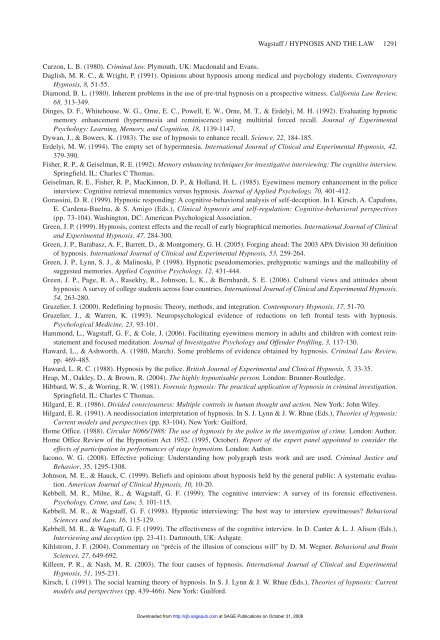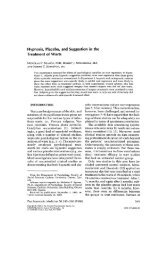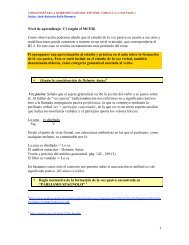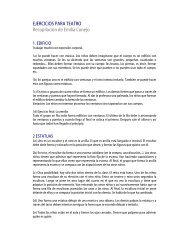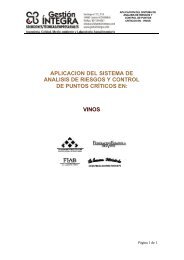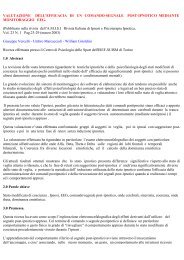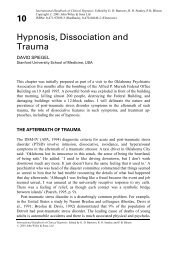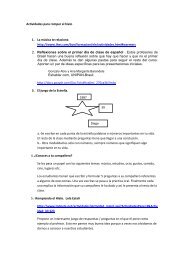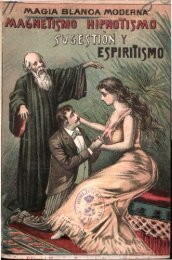Hypnosis and the Law: Examining the Stereotypes
Hypnosis and the Law: Examining the Stereotypes
Hypnosis and the Law: Examining the Stereotypes
Create successful ePaper yourself
Turn your PDF publications into a flip-book with our unique Google optimized e-Paper software.
Wagstaff / HYPNOSIS AND THE LAW 1291<br />
Curzon, L. B. (1980). Criminal law. Plymouth, UK: Macdonald <strong>and</strong> Evans.<br />
Daglish, M. R. C., & Wright, P. (1991). Opinions about hypnosis among medical <strong>and</strong> psychology students. Contemporary<br />
<strong>Hypnosis</strong>, 8, 51-55.<br />
Diamond, B. L. (1980). Inherent problems in <strong>the</strong> use of pre-trial hypnosis on a prospective witness. California <strong>Law</strong> Review,<br />
68, 313-349.<br />
Dinges, D. F., Whitehouse, W. G., Orne, E. C., Powell, E. W., Orne, M. T., & Erdelyi, M. H. (1992). Evaluating hypnotic<br />
memory enhancement (hypermnesia <strong>and</strong> reminiscence) using multitrial forced recall. Journal of Experimental<br />
Psychology: Learning, Memory, <strong>and</strong> Cognition, 18, 1139-1147.<br />
Dywan, J., & Bowers, K. (1983). The use of hypnosis to enhance recall. Science, 22, 184-185.<br />
Erdelyi, M. W. (1994). The empty set of hypermnesia. International Journal of Clinical <strong>and</strong> Experimental <strong>Hypnosis</strong>, 42,<br />
379-390.<br />
Fisher, R. P., & Geiselman, R. E. (1992). Memory enhancing techniques for investigative interviewing: The cognitive interview.<br />
Springfield, IL: Charles C Thomas.<br />
Geiselman, R. E., Fisher, R. P., MacKinnon, D. P., & Holl<strong>and</strong>, H. L. (1985). Eyewitness memory enhancement in <strong>the</strong> police<br />
interview: Cognitive retrieval mnemonics versus hypnosis. Journal of Applied Psychology, 70, 401-412.<br />
Gorassini, D. R. (1999). Hypnotic responding: A cognitive-behavioral analysis of self-deception. In I. Kirsch, A. Capafons,<br />
E. Cardena-Buelna, & S. Amigo (Eds.), Clinical hypnosis <strong>and</strong> self-regulation: Cognitive-behavioral perspectives<br />
(pp. 73-104). Washington, DC: American Psychological Association.<br />
Green, J. P. (1999). <strong>Hypnosis</strong>, context effects <strong>and</strong> <strong>the</strong> recall of early biographical memories. International Journal of Clinical<br />
<strong>and</strong> Experimental <strong>Hypnosis</strong>, 47, 284-300.<br />
Green, J. P., Barabasz, A. F., Barrett, D., & Montgomery, G. H. (2005). Forging ahead: The 2003 APA Division 30 definition<br />
of hypnosis. International Journal of Clinical <strong>and</strong> Experimental <strong>Hypnosis</strong>, 53, 259-264.<br />
Green, J. P., Lynn, S. J., & Malinoski, P. (1998). Hypnotic pseudomemories, prehypnotic warnings <strong>and</strong> <strong>the</strong> malleability of<br />
suggested memories. Applied Cognitive Psychology, 12, 431-444.<br />
Green, J. P., Page, R. A., Rasekhy, R., Johnson, L. K., & Bernhardt, S. E. (2006). Cultural views <strong>and</strong> attitudes about<br />
hypnosis: A survey of college students across four countries. International Journal of Clinical <strong>and</strong> Experimental <strong>Hypnosis</strong>,<br />
54, 263-280.<br />
Gruzelier, J. (2000). Redefining hypnosis: Theory, methods, <strong>and</strong> integration. Contemporary <strong>Hypnosis</strong>, 17, 51-70.<br />
Gruzelier, J., & Warren, K. (1993). Neuropsychological evidence of reductions on left frontal tests with hypnosis.<br />
Psychological Medicine, 23, 93-101.<br />
Hammond, L., Wagstaff, G. F., & Cole, J. (2006). Facilitating eyewitness memory in adults <strong>and</strong> children with context reinstatement<br />
<strong>and</strong> focused meditation. Journal of Investigative Psychology <strong>and</strong> Offender Profiling, 3, 117-130.<br />
Haward, L., & Ashworth, A. (1980, March). Some problems of evidence obtained by hypnosis. Criminal <strong>Law</strong> Review,<br />
pp. 469-485.<br />
Haward, L. R. C. (1988). <strong>Hypnosis</strong> by <strong>the</strong> police. British Journal of Experimental <strong>and</strong> Clinical <strong>Hypnosis</strong>, 5, 33-35.<br />
Heap, M., Oakley, D., & Brown, R. (2004). The highly hypnotisable person. London: Brunner-Routledge.<br />
Hibbard, W. S., & Worring, R. W. (1981). Forensic hypnosis: The practical application of hypnosis in criminal investigation.<br />
Springfield, IL: Charles C Thomas.<br />
Hilgard, E. R. (1986). Divided consciousness: Multiple controls in human thought <strong>and</strong> action. New York: John Wiley.<br />
Hilgard, E. R. (1991). A neodissociation interpretation of hypnosis. In S. J. Lynn & J. W. Rhue (Eds.), Theories of hypnosis:<br />
Current models <strong>and</strong> perspectives (pp. 83-104). New York: Guilford.<br />
Home Office. (1988). Circular N066/1988: The use of hypnosis by <strong>the</strong> police in <strong>the</strong> investigation of crime. London: Author.<br />
Home Office Review of <strong>the</strong> Hypnotism Act 1952. (1995, October). Report of <strong>the</strong> expert panel appointed to consider <strong>the</strong><br />
effects of participation in performances of stage hypnotism. London: Author.<br />
Iacono, W. G. (2008). Effective policing: Underst<strong>and</strong>ing how polygraph tests work <strong>and</strong> are used. Criminal Justice <strong>and</strong><br />
Behavior, 35, 1295-1308.<br />
Johnson, M. E., & Hauck, C. (1999). Beliefs <strong>and</strong> opinions about hypnosis held by <strong>the</strong> general public: A systematic evaluation.<br />
American Journal of Clinical <strong>Hypnosis</strong>, 10, 10-20.<br />
Kebbell, M. R., Milne, R., & Wagstaff, G. F. (1999). The cognitive interview: A survey of its forensic effectiveness.<br />
Psychology, Crime, <strong>and</strong> <strong>Law</strong>, 5, 101-115.<br />
Kebbell, M. R., & Wagstaff, G. F. (1998). Hypnotic interviewing: The best way to interview eyewitnesses? Behavioral<br />
Sciences <strong>and</strong> <strong>the</strong> <strong>Law</strong>, 16, 115-129.<br />
Kebbell, M. R., & Wagstaff, G. F. (1999). The effectiveness of <strong>the</strong> cognitive interview. In D. Canter & L. J. Alison (Eds.),<br />
Interviewing <strong>and</strong> deception (pp. 23-41). Dartmouth, UK: Ashgate.<br />
Kihlstrom, J. F. (2004). Commentary on “précis of <strong>the</strong> illusion of conscious will” by D. M. Wegner. Behavioral <strong>and</strong> Brain<br />
Sciences, 27, 649-692.<br />
Killeen, P. R., & Nash, M. R. (2003). The four causes of hypnosis. International Journal of Clinical <strong>and</strong> Experimental<br />
<strong>Hypnosis</strong>, 51, 195-231.<br />
Kirsch, I. (1991). The social learning <strong>the</strong>ory of hypnosis. In S. J. Lynn & J. W. Rhue (Eds.), Theories of hypnosis: Current<br />
models <strong>and</strong> perspectives (pp. 439-466). New York: Guilford.<br />
Downloaded from<br />
http://cjb.sagepub.com at SAGE Publications on October 31, 2008


